Ayush Tewari
Max Planck Institute for Informatics, Saarland Informatics Campus
PickScan: Object discovery and reconstruction from handheld interactions
Nov 17, 2024



Abstract:Reconstructing compositional 3D representations of scenes, where each object is represented with its own 3D model, is a highly desirable capability in robotics and augmented reality. However, most existing methods rely heavily on strong appearance priors for object discovery, therefore only working on those classes of objects on which the method has been trained, or do not allow for object manipulation, which is necessary to scan objects fully and to guide object discovery in challenging scenarios. We address these limitations with a novel interaction-guided and class-agnostic method based on object displacements that allows a user to move around a scene with an RGB-D camera, hold up objects, and finally outputs one 3D model per held-up object. Our main contribution to this end is a novel approach to detecting user-object interactions and extracting the masks of manipulated objects. On a custom-captured dataset, our pipeline discovers manipulated objects with 78.3% precision at 100% recall and reconstructs them with a mean chamfer distance of 0.90cm. Compared to Co-Fusion, the only comparable interaction-based and class-agnostic baseline, this corresponds to a reduction in chamfer distance of 73% while detecting 99% fewer false positives.
GAURA: Generalizable Approach for Unified Restoration and Rendering of Arbitrary Views
Jul 11, 2024Abstract:Neural rendering methods can achieve near-photorealistic image synthesis of scenes from posed input images. However, when the images are imperfect, e.g., captured in very low-light conditions, state-of-the-art methods fail to reconstruct high-quality 3D scenes. Recent approaches have tried to address this limitation by modeling various degradation processes in the image formation model; however, this limits them to specific image degradations. In this paper, we propose a generalizable neural rendering method that can perform high-fidelity novel view synthesis under several degradations. Our method, GAURA, is learning-based and does not require any test-time scene-specific optimization. It is trained on a synthetic dataset that includes several degradation types. GAURA outperforms state-of-the-art methods on several benchmarks for low-light enhancement, dehazing, deraining, and on-par for motion deblurring. Further, our model can be efficiently fine-tuned to any new incoming degradation using minimal data. We thus demonstrate adaptation results on two unseen degradations, desnowing and removing defocus blur. Code and video results are available at vinayak-vg.github.io/GAURA.
FlowMap: High-Quality Camera Poses, Intrinsics, and Depth via Gradient Descent
Apr 23, 2024



Abstract:This paper introduces FlowMap, an end-to-end differentiable method that solves for precise camera poses, camera intrinsics, and per-frame dense depth of a video sequence. Our method performs per-video gradient-descent minimization of a simple least-squares objective that compares the optical flow induced by depth, intrinsics, and poses against correspondences obtained via off-the-shelf optical flow and point tracking. Alongside the use of point tracks to encourage long-term geometric consistency, we introduce differentiable re-parameterizations of depth, intrinsics, and pose that are amenable to first-order optimization. We empirically show that camera parameters and dense depth recovered by our method enable photo-realistic novel view synthesis on 360-degree trajectories using Gaussian Splatting. Our method not only far outperforms prior gradient-descent based bundle adjustment methods, but surprisingly performs on par with COLMAP, the state-of-the-art SfM method, on the downstream task of 360-degree novel view synthesis (even though our method is purely gradient-descent based, fully differentiable, and presents a complete departure from conventional SfM).
Diffusion Posterior Illumination for Ambiguity-aware Inverse Rendering
Sep 30, 2023Abstract:Inverse rendering, the process of inferring scene properties from images, is a challenging inverse problem. The task is ill-posed, as many different scene configurations can give rise to the same image. Most existing solutions incorporate priors into the inverse-rendering pipeline to encourage plausible solutions, but they do not consider the inherent ambiguities and the multi-modal distribution of possible decompositions. In this work, we propose a novel scheme that integrates a denoising diffusion probabilistic model pre-trained on natural illumination maps into an optimization framework involving a differentiable path tracer. The proposed method allows sampling from combinations of illumination and spatially-varying surface materials that are, both, natural and explain the image observations. We further conduct an extensive comparative study of different priors on illumination used in previous work on inverse rendering. Our method excels in recovering materials and producing highly realistic and diverse environment map samples that faithfully explain the illumination of the input images.
Approaching human 3D shape perception with neurally mappable models
Sep 07, 2023Abstract:Humans effortlessly infer the 3D shape of objects. What computations underlie this ability? Although various computational models have been proposed, none of them capture the human ability to match object shape across viewpoints. Here, we ask whether and how this gap might be closed. We begin with a relatively novel class of computational models, 3D neural fields, which encapsulate the basic principles of classic analysis-by-synthesis in a deep neural network (DNN). First, we find that a 3D Light Field Network (3D-LFN) supports 3D matching judgments well aligned to humans for within-category comparisons, adversarially-defined comparisons that accentuate the 3D failure cases of standard DNN models, and adversarially-defined comparisons for algorithmically generated shapes with no category structure. We then investigate the source of the 3D-LFN's ability to achieve human-aligned performance through a series of computational experiments. Exposure to multiple viewpoints of objects during training and a multi-view learning objective are the primary factors behind model-human alignment; even conventional DNN architectures come much closer to human behavior when trained with multi-view objectives. Finally, we find that while the models trained with multi-view learning objectives are able to partially generalize to new object categories, they fall short of human alignment. This work provides a foundation for understanding human shape inferences within neurally mappable computational architectures.
Diffusion with Forward Models: Solving Stochastic Inverse Problems Without Direct Supervision
Jun 20, 2023


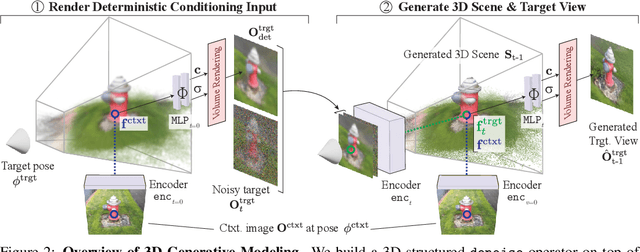
Abstract:Denoising diffusion models are a powerful type of generative models used to capture complex distributions of real-world signals. However, their applicability is limited to scenarios where training samples are readily available, which is not always the case in real-world applications. For example, in inverse graphics, the goal is to generate samples from a distribution of 3D scenes that align with a given image, but ground-truth 3D scenes are unavailable and only 2D images are accessible. To address this limitation, we propose a novel class of denoising diffusion probabilistic models that learn to sample from distributions of signals that are never directly observed. Instead, these signals are measured indirectly through a known differentiable forward model, which produces partial observations of the unknown signal. Our approach involves integrating the forward model directly into the denoising process. This integration effectively connects the generative modeling of observations with the generative modeling of the underlying signals, allowing for end-to-end training of a conditional generative model over signals. During inference, our approach enables sampling from the distribution of underlying signals that are consistent with a given partial observation. We demonstrate the effectiveness of our method on three challenging computer vision tasks. For instance, in the context of inverse graphics, our model enables direct sampling from the distribution of 3D scenes that align with a single 2D input image.
AvatarStudio: Text-driven Editing of 3D Dynamic Human Head Avatars
Jun 02, 2023Abstract:Capturing and editing full head performances enables the creation of virtual characters with various applications such as extended reality and media production. The past few years witnessed a steep rise in the photorealism of human head avatars. Such avatars can be controlled through different input data modalities, including RGB, audio, depth, IMUs and others. While these data modalities provide effective means of control, they mostly focus on editing the head movements such as the facial expressions, head pose and/or camera viewpoint. In this paper, we propose AvatarStudio, a text-based method for editing the appearance of a dynamic full head avatar. Our approach builds on existing work to capture dynamic performances of human heads using neural radiance field (NeRF) and edits this representation with a text-to-image diffusion model. Specifically, we introduce an optimization strategy for incorporating multiple keyframes representing different camera viewpoints and time stamps of a video performance into a single diffusion model. Using this personalized diffusion model, we edit the dynamic NeRF by introducing view-and-time-aware Score Distillation Sampling (VT-SDS) following a model-based guidance approach. Our method edits the full head in a canonical space, and then propagates these edits to remaining time steps via a pretrained deformation network. We evaluate our method visually and numerically via a user study, and results show that our method outperforms existing approaches. Our experiments validate the design choices of our method and highlight that our edits are genuine, personalized, as well as 3D- and time-consistent.
FlowCam: Training Generalizable 3D Radiance Fields without Camera Poses via Pixel-Aligned Scene Flow
May 31, 2023Abstract:Reconstruction of 3D neural fields from posed images has emerged as a promising method for self-supervised representation learning. The key challenge preventing the deployment of these 3D scene learners on large-scale video data is their dependence on precise camera poses from structure-from-motion, which is prohibitively expensive to run at scale. We propose a method that jointly reconstructs camera poses and 3D neural scene representations online and in a single forward pass. We estimate poses by first lifting frame-to-frame optical flow to 3D scene flow via differentiable rendering, preserving locality and shift-equivariance of the image processing backbone. SE(3) camera pose estimation is then performed via a weighted least-squares fit to the scene flow field. This formulation enables us to jointly supervise pose estimation and a generalizable neural scene representation via re-rendering the input video, and thus, train end-to-end and fully self-supervised on real-world video datasets. We demonstrate that our method performs robustly on diverse, real-world video, notably on sequences traditionally challenging to optimization-based pose estimation techniques.
Drag Your GAN: Interactive Point-based Manipulation on the Generative Image Manifold
May 18, 2023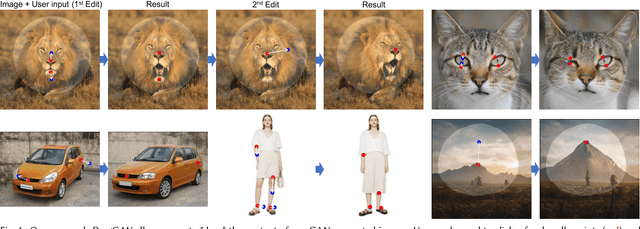


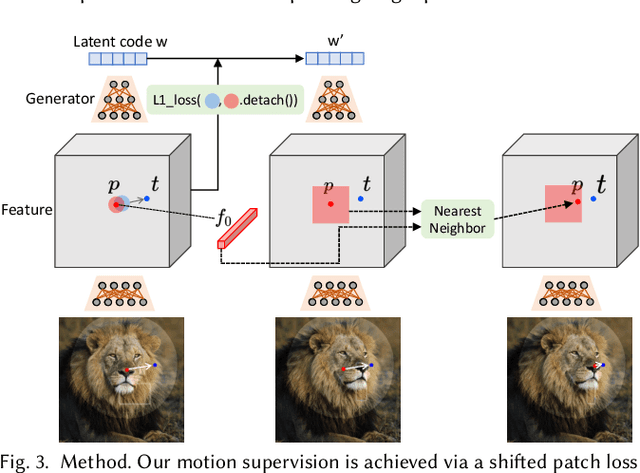
Abstract:Synthesizing visual content that meets users' needs often requires flexible and precise controllability of the pose, shape, expression, and layout of the generated objects. Existing approaches gain controllability of generative adversarial networks (GANs) via manually annotated training data or a prior 3D model, which often lack flexibility, precision, and generality. In this work, we study a powerful yet much less explored way of controlling GANs, that is, to "drag" any points of the image to precisely reach target points in a user-interactive manner, as shown in Fig.1. To achieve this, we propose DragGAN, which consists of two main components: 1) a feature-based motion supervision that drives the handle point to move towards the target position, and 2) a new point tracking approach that leverages the discriminative generator features to keep localizing the position of the handle points. Through DragGAN, anyone can deform an image with precise control over where pixels go, thus manipulating the pose, shape, expression, and layout of diverse categories such as animals, cars, humans, landscapes, etc. As these manipulations are performed on the learned generative image manifold of a GAN, they tend to produce realistic outputs even for challenging scenarios such as hallucinating occluded content and deforming shapes that consistently follow the object's rigidity. Both qualitative and quantitative comparisons demonstrate the advantage of DragGAN over prior approaches in the tasks of image manipulation and point tracking. We also showcase the manipulation of real images through GAN inversion.
Learning to Render Novel Views from Wide-Baseline Stereo Pairs
Apr 17, 2023
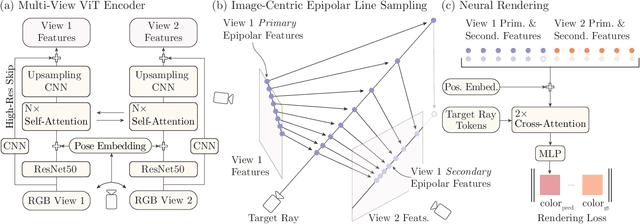
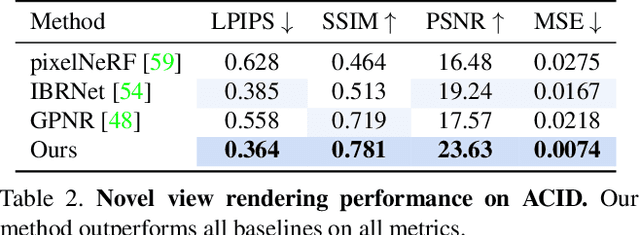
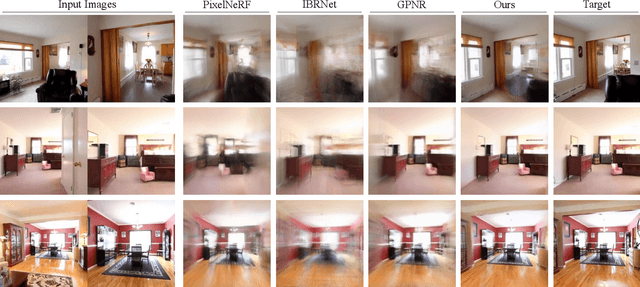
Abstract:We introduce a method for novel view synthesis given only a single wide-baseline stereo image pair. In this challenging regime, 3D scene points are regularly observed only once, requiring prior-based reconstruction of scene geometry and appearance. We find that existing approaches to novel view synthesis from sparse observations fail due to recovering incorrect 3D geometry and due to the high cost of differentiable rendering that precludes their scaling to large-scale training. We take a step towards resolving these shortcomings by formulating a multi-view transformer encoder, proposing an efficient, image-space epipolar line sampling scheme to assemble image features for a target ray, and a lightweight cross-attention-based renderer. Our contributions enable training of our method on a large-scale real-world dataset of indoor and outdoor scenes. We demonstrate that our method learns powerful multi-view geometry priors while reducing the rendering time. We conduct extensive comparisons on held-out test scenes across two real-world datasets, significantly outperforming prior work on novel view synthesis from sparse image observations and achieving multi-view-consistent novel view synthesis.
 Add to Chrome
Add to Chrome Add to Firefox
Add to Firefox Add to Edge
Add to Edge